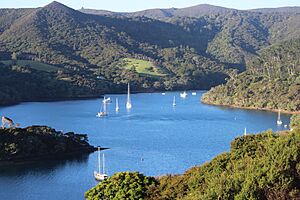Port Fitzroy facts for kids
Port Fitzroy is a beautiful harbour and small community located on Great Barrier Island in New Zealand. It's part of the Hauraki Gulf, a large area of water near Auckland. This special place is known for its calm waters and natural beauty.
Contents
Discovering Port Fitzroy
A Safe Spot for Boats
Port Fitzroy is the biggest natural harbour in the Hauraki Gulf. A nearby island called Kaikoura Island helps protect the harbour. This makes it a very safe place for boats, especially yachts, in almost any kind of weather. Many boat owners from Auckland visit Port Fitzroy, especially during the summer holidays and around Christmas. Boats often stop here to get fuel, water, and other supplies.
What You Can Find Here
Even though it's a small community, Port Fitzroy has a few important services for visitors. There are two main businesses that help people on boats. The Port FitzRoy Store is one of only four grocery stores on Great Barrier Island. This is where people can buy food and other daily items. Port FitzRoy Fuel sells fuel for both cars and boats. Because it's in a remote spot, the fuel here can be quite expensive compared to other places in New Zealand.
In 2019, the Auckland Council started a special service during summer. This service lets boaters drop off their rubbish. It helps to stop people from throwing waste into the ocean, keeping the harbour clean and healthy.
Fun Things to Do
Port Fitzroy is also a place where people grow seafood. There are special farms in the calm waters that raise shellfish, like mussels. Every year, there's a fun event called Musselfest. It's a celebration of these tasty mussels!
If you love exploring nature, there are great walking trails nearby. The Warren's Track and Bridle Track are managed by the Department of Conservation. As you walk along these tracks, you can see a beautiful waterfall and deep pools perfect for swimming. The trails pass through a mix of native New Zealand trees and other types of forests.
Climate
| Climate data for Port Fitzroy (1991–2020 normals, extremes 1961–2003) | |||||||||||||
|---|---|---|---|---|---|---|---|---|---|---|---|---|---|
| Month | Jan | Feb | Mar | Apr | May | Jun | Jul | Aug | Sep | Oct | Nov | Dec | Year |
| Record high °C (°F) | 28.7 (83.7) |
29.9 (85.8) |
27.5 (81.5) |
25.9 (78.6) |
22.8 (73.0) |
22.5 (72.5) |
19.5 (67.1) |
20.2 (68.4) |
21.5 (70.7) |
23.4 (74.1) |
24.3 (75.7) |
27.1 (80.8) |
29.9 (85.8) |
| Mean daily maximum °C (°F) | 23.9 (75.0) |
24.0 (75.2) |
22.8 (73.0) |
20.9 (69.6) |
18.5 (65.3) |
16.5 (61.7) |
15.7 (60.3) |
15.9 (60.6) |
17.2 (63.0) |
18.5 (65.3) |
20.3 (68.5) |
22.4 (72.3) |
19.7 (67.5) |
| Daily mean °C (°F) | 19.7 (67.5) |
20.1 (68.2) |
18.9 (66.0) |
16.9 (62.4) |
15.0 (59.0) |
13.1 (55.6) |
12.2 (54.0) |
12.4 (54.3) |
13.4 (56.1) |
14.8 (58.6) |
16.4 (61.5) |
18.5 (65.3) |
16.0 (60.7) |
| Mean daily minimum °C (°F) | 15.4 (59.7) |
16.2 (61.2) |
15.0 (59.0) |
13.0 (55.4) |
11.4 (52.5) |
9.7 (49.5) |
8.8 (47.8) |
8.9 (48.0) |
9.7 (49.5) |
11.1 (52.0) |
12.5 (54.5) |
14.6 (58.3) |
12.2 (54.0) |
| Record low °C (°F) | 7.0 (44.6) |
6.2 (43.2) |
5.6 (42.1) |
4.5 (40.1) |
1.7 (35.1) |
0.2 (32.4) |
0.4 (32.7) |
1.3 (34.3) |
2.3 (36.1) |
1.9 (35.4) |
3.3 (37.9) |
7.3 (45.1) |
0.2 (32.4) |
| Average rainfall mm (inches) | 92.3 (3.63) |
120.0 (4.72) |
134.1 (5.28) |
115.1 (4.53) |
159.0 (6.26) |
165.8 (6.53) |
245.6 (9.67) |
178.2 (7.02) |
132.0 (5.20) |
99.8 (3.93) |
102.7 (4.04) |
127.6 (5.02) |
1,672.2 (65.83) |
| Source: NIWA | |||||||||||||


